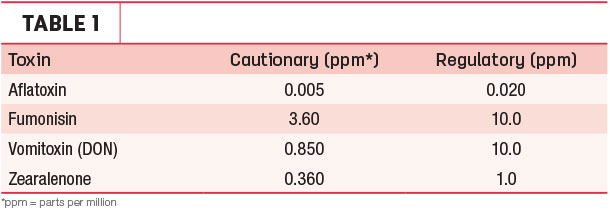The 2016 crop-growing season has resulted in some unique challenges when feeding lactating and growing dairy cattle.
While much has been written in popular magazines about the 2016 corn grain crop and the mycotoxin challenges across the country, the 2016 corn silage crop has some of the same mycotoxin challenges. Mycotoxin-contaminated corn silage may not be the first concern or even come to mind when troubleshooting performance issues on a dairy operation.
Dairy producers may be thinking that the harvesting and ensiling process may destroy mycotoxins. Mycotoxins are produced by mold growth under the appropriate environmental (field) conditions, and the mycotoxins produced are very stable compounds (i.e., difficult to break down, destroy or degrade).
In addition, microbial inoculation will not reduce the mycotoxin concentration because microbial silage inoculants are designed to convert sugars to lactic acid for long-term storage. Microbial silage inoculates do not usually contain technologies to degrade mycotoxins.
Thus, if mycotoxins are in the harvested crop, they are going to be present in the corn silage pile.
For dairy producers, with their much more widely specialized forage feeding situations, grains and byproducts, mycotoxins can present some unique and nasty situations to resolve on the dairy operation. One of these unique challenges when dealing with mycotoxin issues is that corn silage may not be the only source of the problem.
Dairy producers need to be critically aware that mycotoxin concentrations can add up across several feed ingredients on the operation to influence animal performance. For example, if mycotoxins are present in the corn crop, they will be concentrated in the corn byproducts (i.e., corn gluten feed, corn distillers grains, etc.).
So the dairy producer has to be concerned that while any one ingredient may have some mycotoxins, and the concentrations are below action levels, feeding a combination of mycotoxin-contaminated corn, corn gluten feed and corn silage could increase the mycotoxin concentrations in the ration to concentrations that will harm animal health and performance.
Animal performance can be affected in several ways when feeding mycotoxin-contaminated feeds, and the decrease in animal performance will depend on the type of mycotoxin and its concentration in the ration.
While research has been conducted with specific mycotoxins added to the ration (i.e., vomitoxin), the concentrations in the field cause performance problems long before the research concentrations are reached.
The reason for this observation is that we know very little about the combination of different mycotoxins affecting animal performance.
It is also important to realize that many mycotoxins have synergistic effects – meaning two mycotoxins, each below the recognized tolerances, together can bring about negative consequences for the dairy animal.
For example, most commercial laboratories test for the five major mycotoxins of aflatoxin, fumonisin, vomitoxin, zearalenone and T-2 toxin; however, highly specialized laboratories using highly sophisticated equipment can test for more than 17 mycotoxins.
To date, over 400 different mycotoxins have been identified, while we know and understand very little about the potential combinations and their interactions.
For our dairy customers, we have undertaken a more aggressive mycotoxin testing program this past fall as reports of mycotoxin concerns were being identified with the 2016 corn crop.
Of the corn grain samples submitted, approximately 85 percent of the samples tested positive for vomitoxin with concentrations ranging from the lower laboratory detection concentration of 0.1 parts per million (ppm) to a maximum of 4.1 ppm.
Fewer corn grain samples tested positive for fumonisin (38 percent), with a range from the low laboratory detection concentration of 0.1 ppm to 12 ppm, and zearalenone (42 percent) with a range of lower laboratory detection concentration of 0.05 ppm to 1.8 ppm.
Also, the corn byproduct, distillers grains, has been routinely tested with approximately 70 percent of the samples testing positive for vomitoxin with a range of 1.1 to 3.4 ppm.
However, approximately 35 and 17 percent of the samples tested positive for zearalenone and fumonisin, respectively. It would appear from our testing program that vomitoxin is the major mycotoxin, followed by zearalenone and then fumonisin.
In agreement with the corn crop, approximately 80 percent of the corn silage samples that were submitted tested positive for vomitoxin up to 6 ppm. Only 20 percent of the submitted corn silage samples were positive for fumonisin and zearalenone, with maximum concentrations of less than 1.0 ppm.
The incidence rate of mycotoxins found in our samples may be higher than other recently quoted sources because samples were only tested for mycotoxins if problems were suspected on the dairy operation.
Thus, our sampling protocol would be biased toward having more positive samples compared to the entire U.S. corn crop.
What is encouraging is that none of our corn, corn silage or corn byproduct samples tested positive for aflatoxin, which is a known carcinogenic compound and can be transferred to milk if the concentrations are high enough (i.e., greater than 20 parts per billion).
Animal performance can be affected in many different ways when feeding mycotoxin-contaminated feeds and forages, which may include but are not limited to: reduced milk production, reduced milk components, higher somatic cell counts, reduced dry matter intake, poor feed conversion, digestive upsets, irregular heat cycles, embryonic death, high services per conception, lower pregnancy rates, altered hormonal systems, suppressed immune function, etc.
These observations can be observed not only in dairy cows but in growing dairy heifers as well.
Recently, an Ohio heifer raiser reported that feeding a corn silage-based ration with distillers gains and corn gluten feed along with other byproducts resulted in breeding-age heifers having lower pregnancy rates and a greater number of heifers coming open after the second pregnancy check (i.e., 70 to 105 days).
This would be an example of early embryonic deaths in confirmed pregnant heifers being fed corn silage and corn byproducts that are potentially contributing to the mycotoxin-induced reproductive efficiency challenge on the dairy operation.
The Food and Drug Administration does publish cautionary and regulatory guidelines for mycotoxin concentrations in feeds for dairy cattle (Table 1). While the FDA allows blending of feeds to reduce mycotoxin concentrations, it does not allow blending down an ingredient that exceeds the regulatory concentrations.
 Another key regulatory point is that the FDA does not recognize any feed additive or product claiming to have mycotoxin mitigation characteristics. However, various feed additives can be included in the ration to support the animal’s immune system when feeding mycotoxin-containing feeds and forages that may improve animal health and performance during these stressful feeding situations.
Another key regulatory point is that the FDA does not recognize any feed additive or product claiming to have mycotoxin mitigation characteristics. However, various feed additives can be included in the ration to support the animal’s immune system when feeding mycotoxin-containing feeds and forages that may improve animal health and performance during these stressful feeding situations.
In conclusion, this year’s corn crop, along with corn silage and corn byproducts, are plagued by a high percentage containing mycotoxins. The major mycotoxin appears to be vomitoxin, followed by zearalenone and fumonisin.
These mycotoxins are known to influence animal health and performance, and monitoring is crucial along with feeding nutrient-dense rations that support the animal’s immune and digestive systems.
Feed additives can be beneficial in these situations to support the animal’s productive performance and would be desirable for feeding the 2016 corn crop.
For example, for our clients, we are combating these problems by using additives and readjusting rations to contain more alfalfa and soybean meal while reducing the inclusion rate of corn silage and byproducts to maintain nutrient supply to the dairy cow or heifer. ![]()
PHOTO: While silage by itself might have acceptable mycotoxin levels, when combined with other corn products and byproducts, the cumulative effect can still be dangerous. Photo by Lynn Jaynes.
David P. Casper is a dairy nutritionist with Furst-McNess Company. He has been specializing in the research and development of feeding programs for dairy cattle for more than 30 years.

-
David P. Casper
- Dairy Nutritionist
- Furst-McNess Company
- Email David P. Casper






